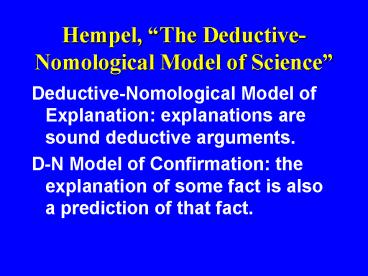Hempel, The DeductiveNomological Model of Science - PowerPoint PPT Presentation
1 / 15
Title:
Hempel, The DeductiveNomological Model of Science
Description:
Hempel, 'The Deductive-Nomological Model of Science' ... The explanation of some fact is also ... 1. Most predictions/explanations in science are not deductive ... – PowerPoint PPT presentation
Number of Views:1077
Avg rating:3.0/5.0
Title: Hempel, The DeductiveNomological Model of Science
1
Hempel, The Deductive-Nomological Model of
Science
- Deductive-Nomological Model of Explanation
explanations are sound deductive arguments. - D-N Model of Confirmation the explanation of
some fact is also a prediction of that fact.
2
D-N Model of Explanation
- explanandum sentence sentence describing the
event or phenomenon to be explained - explanans sentences contain the explanatory
information - In a good explanation, the explanans deductively
implies the explanandum.
3
Explanans sentences
- The explanans consists of two kinds of sentences
- 1. General laws that express uniform empirical
connections. - 2. Descriptions of facts.
4
Schematic for D-N Explanation
- L1,...,Ln (General laws)
- C1,...,Cm (Descriptions of facts)
- E (Explanandum event)
5
Summary on Explanation
- Hempels examples are designed to show that the
D-N model accounts for how both particular facts
and uniformities in nature can be explained by
science. Namely, by using a deductive argument
in which the thing to be explained, the
explanandum, is the conclusion.
6
D-N Model of Confirmation
- The explanation of some fact is also a prediction
of that fact. - When a prediction is born out by observation,
that is some confirming evidence for the theory.
7
Problem for D-N Confirmation
- The evidence for a theory is minimal and mainly
negative, based on the following modus tollens
argument - P1. If (L1,...,Ln and C1,...,Cm) then E.
- P2. Not E.
- C. Therefore, not (L1,...,Ln and C1,...,Cm)
8
Modus Tollens
- Modus Tollens is a valid deductive argument form
- If p then q.
- Not q.
- Therefore not p.
9
Example of Modus Tollens
- If the body theory of personal identity is
correct, then one is not the same person whenever
one loses body parts. But losing ones hand does
not make one a different person. Therefore the
body theory of personal identity is not correct.
10
Structure and Purpose of Scientific Theories
- explain a set of uniformities as a manifestation
of some underlying processes and entities. - specify clearly and precisely the basic entities
and processes that occur in nature - examples Newtonian physics kinetic theory of
gases
11
Theories, continued
- This clarity and precision allows deduction of
regularities and hence tests of the theory. - Thus the clarity and precision of scientific
theories sets science apart from unscientific
theories.
12
Derivation of Predictions
- Theory must specify both internal principles
(which characterize basic entities, processes,
and laws of theory) and bridge principles. - The bridge principles tie the theoretical terms
to the pre-theoretical or everyday terms. - Prediction is derived by deduction from theory
and initial conditions.
13
Virtues of Theories
- Theories broaden and deepen understanding of
nature in three ways - 1. offer a systematic, unified account of diverse
phenomena - 2. show how previous theories hold approximately
- 3. predict and explain new(ly discovered)
phenomena
14
Problems with Hempels Picture of Science
- 1. Most predictions/explanations in science are
not deductive - This led Hempel to introduce the
Inductive-Statistical model - L1,...,Ln
- C1,...,Cm
- implies with high probablility
- E
15
Problems, continued
- 2. However, as Popper argues, induction is a
flimsy method of confirmation of theories or laws
- 3. Laws are astonishingly difficult to
characterize































